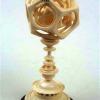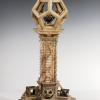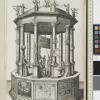Kepler's Mysterium cosmographicum, 1596
Commentary
Kepler’s Mysterium cosmographicum
Johannes Kepler, Prodromus dissertationum cosmographicarum, continens mysterium cosmographicum, de admirabili proportione orbium cœlestium. Addita est Narratio G. Ioachimi de Libris revolutionum N. Copernici. Tübingen: Georg Gruppenbach, 1596. Figure inserted after p. 24.
Physical description: [1] fol., 181 pp. ; 20 cm : Ill. (5 tables)
Bibliographical reference: VD16 K 754
Source. Bodleian Library, shelfmark Savile Y 15
Commentary. This figure provides a synopsis of Kepler’s cosmology at this stage of development. Translation and commentary on the figure, along with a précis of the text as a whole, is provided in 'Astronomical Images: Diagrams, Figures, and the Transformation of Astronomy, 1450-1650' (unfortunately now password protected).
Full digital facsimiles available on e-rara, SLUB Dresden, and HAB Wolfenbüttel.
Translation: Johannes Kepler, Mysterium Cosmographicum: The Secrets of the Universe, trans. A. M. Duncan (New York, 1981).
Resources. What are Platonic solids? Why are there only five of them? What is their relationship to one another? Why did Kepler consider nesting them in this way? Answers to most of these questions can be found in the following animated discussion, created by Swarthmore College.



